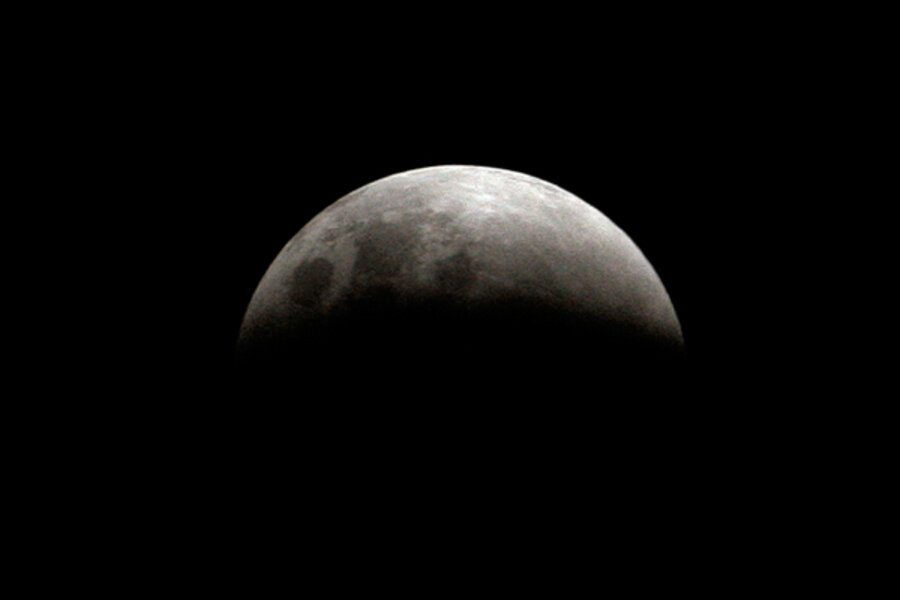Partial lunar eclipse coming on June 26
Loading...
Two weeks before a total eclipse of the sun crosses over the South Pacific Ocean, the moon will put on a sky show of its own — a partial lunar eclipse on June 26 that should be visible from parts of North America, weather permitting.
The lunar eclipse will occur in the early morning hours of Saturday, June 26 as the moon crosses through the southern portion of Earth's shadow in the constellation Sagittarius. At least some of this interesting event will be visible from western and central North America.
Half-hidden moon
At its peak, slightly more than half of the moon's diameter will be dramatically darkened, possibly tinged slightly with a mixture of faint orange and reddish hues. [More lunar eclipse photos.]
These, in fact, are the filtered glows of innumerable sunsets and sunrises occurring around the rim of the Earth at the time. But partial eclipses generally lack the colorful orange-red hues that a total lunar eclipse often shows.
At this upcoming eclipse, no more than 53.7 percent of the moon's diameter dips inside the dark central core of the Earth's shadow, which is called the umbra. That leaves almost half of the moon's disk in the shadow's outer fringe, known as the penumbra, where a generous dose of direct sunlight still reaches the moon; so the southern half of the moon will appear subdued but otherwise near normal.
Glare from this sunlit portion will make any coloration within the umbra elusive at best. Your best hope of detecting colors is to view the moon with a 100-power (100x) telescope eyepiece or more and maneuver it so that the bright half lies completely outside the field.
Unlike a solar eclipse, whose aspect depends very greatly on an observer's particular location on Earth, a lunar eclipse looks essentially the same from any of the Earth where the moon is above the horizon.
Since the moon will set during the course of the eclipse, some of the stages will not be visible because it will have disappeared below the west-southwest horizon. Here is a timetable of observing times across North America.
CIRCUMSTANCES OF THE JUNE 26, 2010 PARTIAL LUNAR ECLIPSE
| EDT | CDT | MDT | PDT | |
| First bit of shading | 5:50 a.m. | 4:50 a.m. | 3:50 a.m. | 2:50 a.m. |
| Moon enters umbra | 6:17 a.m. | 5:17 a.m. | 4:17 a.m. | 3:17 a.m. |
| Maximum eclipse | Below the horizon | 6:40 a.m. | 5:40 a.m. | 4:40 a.m. |
| Moon leaves umbra | Below the horizon | Below the horizon | Below the horizon | 6:00 a.m. |
| Last bit of shading | Below the horizon | Below the horizon | Below the horizon | 6:25 a.m. |
Regions of Visibility
The first bit of shading will become evident around 5:50 a.m. EDT (0950 GMT), when the moon's upper left portion has moved about two-thirds into the penumbra of the Earth's shadow. The shading will darken for the next 25 minutes or so.
Then at 6:17 a.m. EDT (1017 GMT), the disk's northeast (celestial northeast) enters the dark umbra. At this time the moon is setting (and the sun is rising) along a line running from northwest to southeast from roughly Winnipeg, Manitoba to Savannah, Georgia.
The moon will have already set for observers farther north and east.
For another 83 minutes the dark bite in the moon's edge enlarges until reaching maximum eclipse at 7:40 a.m. EDT (11:40 GMT). Now the umbra extends 54 percent across the disk.
But eastern observers are progressively being shut out of the action. By now the moonset and sunrise lines have shifted west to run from Saskatchewan, Canada, to east Texas.
The moon leaves the umbra at 9 a.m. EDT (1300 GMT), when it is just minutes from setting as seen from along California's Pacific Coast where the local time will be about 6 a.m. The last bit of penumbral shading should be visible around 6:25 a.m. local time.
The entire umbral phase is visible throughout the Pacific, New Zealand, Australia, and Japan. From these locations, the eclipse will take place during Saturday evening, June 26. The point where the moon is directly overhead at maximum eclipse lies over the South Pacific Ocean, far to the southwest of Hawaii.
The next lunar eclipse is a total one later this year on the night of Dec. 20-21, which will be visible from the Americas as well as western portions of Europe.
- Photos: Lunar Eclipse Wows the World
- Top 10 Amazing Moon Facts, Moon Gallery
- Beginner Astrophotography Telescopes
Joe Rao serves as an instructor and guest lecturer at New York's Hayden Planetarium. He writes about astronomy for The New York Times and other publications, and he is also an on-camera meteorologist for News 12 Westchester, New York.





